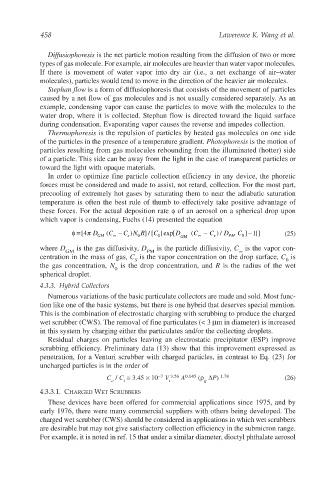Page 486 - Air Pollution Control Engineering
P. 486
12_ch_wang.qxd 05/05/2004 5:26 pm Page 458
458 Lawerence K. Wang et al.
Diffusiophoresis is the net particle motion resulting from the diffusion of two or more
types of gas molecule. For example, air molecules are heavier than water vapor molecules.
If there is movement of water vapor into dry air (i.e., a net exchange of air–water
molecules), particles would tend to move in the direction of the heavier air molecules.
Stephan flow is a form of diffusiophoresis that consists of the movement of particles
caused by a net flow of gas molecules and is not usually considered separately. As an
example, condensing vapor can cause the particles to move with the molecules to the
water drop, where it is collected. Stephan flow is directed toward the liquid surface
during condensation. Evaporating vapor causes the reverse and impedes collection.
Thermophoresis is the repulsion of particles by heated gas molecules on one side
of the particles in the presence of a temperature gradient. Photophoresis is the motion of
particles resulting from gas molecules rebounding from the illuminated (hotter) side
of a particle. This side can be away from the light in the case of transparent particles or
toward the light with opaque materials.
In order to optimize fine particle collection efficiency in any device, the phoretic
forces must be considered and made to assist, not retard, collection. For the most part,
precooling of extremely hot gases by saturating them to near the adiabatic saturation
temperature is often the best rule of thumb to effectively take positive advantage of
these forces. For the actual deposition rate φ of an aerosol on a spherical drop upon
which vapor is condensing, Fuchs (14) presented the equation
φ[4π D GM ( C ∞ − C N R / [ C {exp[ D GM ( C ∞ − C ) / D PM C ] −1}] (25)
=
]
)
s
0
0
s
0
where D is the gas diffusivity, D is the particle diffusivity, C is the vapor con-
GM PM ∞
centration in the mass of gas, C is the vapor concentration on the drop surface, C is
S 0
the gas concentration, N is the drop concentration, and R is the radius of the wet
0
spherical droplet.
4.3.3. Hybrid Collectors
Numerous variations of the basic particulate collectors are made and sold. Most func-
tion like one of the basic systems, but there is one hybrid that deserves special mention.
This is the combination of electrostatic charging with scrubbing to produce the charged
wet scrubber (CWS). The removal of fine particulates (< 3 µm in diameter) is increased
in this system by charging either the particulates and/or the collecting droplets.
Residual charges on particles leaving an electrostatic precipitator (ESP) improve
scrubbing efficiency. Preliminary data (13) show that this improvement expressed as
penetration, for a Venturi scrubber with charged particles, in contrast to Eq. (23) for
uncharged particles is in the order of
C / C ≅ 3.45 × 10 −7 V 3.56 A 0.145 (ρ ∆P) 1.78 (26)
o i t g
4.3.3.1. CHARGED WET SCRUBBERS
These devices have been offered for commercial applications since 1975, and by
early 1976, there were many commercial suppliers with others being developed. The
charged wet scrubber (CWS) should be considered in applications in which wet scrubbers
are desirable but may not give satisfactory collection efficiency in the submicron range.
For example, it is noted in ref. 15 that under a similar diameter, dioctyl phthalate aerosol

